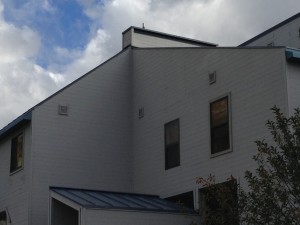Aspen, CO is home to buildings still in use after more than 100 years. While building codes and materials have advanced over time, basic, water-mitigating design elements have existed for decades (and some for centuries). Why a “famous”, accomplished architect and developer intent on providing “quality affordable” housing would deliberately avoid utilizing these common building techniques and materials in an environment which receives significant snowfall for more than 6 months each year is puzzling and frustrating.
Here are photos of neighboring homes of varying ages directly adjacent to Centennial. Please note that the roof ALWAYS extends beyond the structure:
~~~~~~~~~~~~~~~~~~~~~~~
Here are photos of Centennial roof lines. Please note the lack of flashing, eaves, overhangs, drip caps, rain gutters. and downspouts.
[Flashing: a strip of metal used to stop water from penetrating the junction of a roof with another surface.]
Yes, there are overhangs at the edge of many roof lines. These were added by the homeowners at great expense in 1993 and 1994 after it was realized that their homes were leaking due to a complete lack of water-diverting and -resisting elements. The add-on overhangs are not part of the roof and are bolted on to the wall. While construction consultants recommended their installation and verified their effectiveness, they could not stave off the long-term damage caused by the ice dams (poor roof design) and general lack of weatherproofing.
Was it necessary to end the roof at the edge of the building in order to keep sales prices and rental rates affordable
(and sustain profits)?
Or why?

















